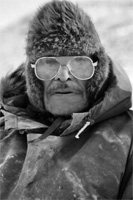
Osuitok Ipeelee
Encyclopedia

Inuit
The Inuit are a group of culturally similar indigenous peoples inhabiting the Arctic regions of Canada , Denmark , Russia and the United States . Inuit means “the people” in the Inuktitut language...
sculptor who lived in Cape Dorset, Nunavut
Cape Dorset, Nunavut
Cape Dorset is an Inuit hamlet located on Dorset Island near Foxe Peninsula at the southern tip of Baffin Island in the Qikiqtaaluk Region of Nunavut, Canada...
. His sculptures in green soapstone
Soapstone
Soapstone is a metamorphic rock, a talc-schist. It is largely composed of the mineral talc and is thus rich in magnesium. It is produced by dynamothermal metamorphism and metasomatism, which occurs in the areas where tectonic plates are subducted, changing rocks by heat and pressure, with influx...
of caribou and birds are particularly esteemed for their balance and delicacy. He was an early collaborator with James Archibald Houston, and by Houston's account was instrumental in the conception of the West Baffin Island Eskimo Cooperative. He was also one of the witnesses of the last-remembered traditional Inuit trial.
Biography

Youth and early work
Ipeelee grew up in a traditional Inuit environment, learning to hunt and fish from his father, Ohotok Ipeelee, at a small camp near Cape Dorset. Ohotok also taught his son how to carve ivory, and as early as the age of thirteen Osuitok began to sculpt. This was encouraged by Roman Catholic missionaries, who bought carvings and commissioned small crucifixes from him. The artist's earliest extant works are ivory miniatures of hunting equipment, typical of the historic period of Inuit art, that date from the 1940s.James Houston and subsequent career
Before Houston's 1951 expedition, Ipeelee was already regionally known as the greatest carver on Baffin IslandBaffin Island
Baffin Island in the Canadian territory of Nunavut is the largest island in the Canadian Arctic Archipelago, the largest island in Canada and the fifth largest island in the world. Its area is and its population is about 11,000...
. Under Houston's influence he began to carve sculptures in soapstone, which had a reliable market in the south. Exhibits of Inuit art at the National Gallery of Canada
National Gallery of Canada
The National Gallery of Canada , located in the capital city Ottawa, Ontario, is one of Canada's premier art galleries.The Gallery is now housed in a glass and granite building on Sussex Drive with a notable view of the Canadian Parliament buildings on Parliament Hill. The acclaimed structure was...
in 1952 and 1955 included his work, crediting him as "Oshaweetuk B". With recognition he began to receive official commissions. In 1955 he directed a team of craftsmen in the creation of the official mace for the Council of the Northwest Territories, and in 1959 he was asked to create a sculpture of Queen Elizabeth II, which was presented to the Queen upon her visit to Canada that year.
The birth of Inuit printmaking
The idea of a Cape Dorset printmaking program developed from a winter 1957 conversation between Houston and Ipeelee.As Houston recalled:
Osuitok Ipeelee sat near me one evening studying the sailor-head trademarks on a number of identical cigarette packages. He...stated that it must have been very tiresome...to sit painting every one of the small heads on the small packages with the exact sameness...
My explanation was far from successful...partly because I was starting to wonder whether this could have any practical application in Inuit terms.
Looking around to find some way to demonstrate printing, I saw an ivory walrus tusk that Osuitok had recently engraved...
Taking an old tin of writing ink... with my finger I dipped into the black residue and smoothed it over the tusk. I laid a piece of toilet paper on the inked surface and rubbed the top lightly, then quickly stripped the paper from the tusk. I saw that by mere good fortune, I had pulled a fairly good negative of Osuitok's incised design.
"We could do that," he said, with the instant decisiveness of a hunter. And so we did.
Despite this, Ipeelee only contributed a total of four prints to the annual print collections, two in 1958 and two in 1959. He never returned to the medium explaining that he had not been paid enough for the drawings on which the prints were based, and found sculpture to be more profitable.
Notable sculptures
- Harpoon Head Figure (1983), serpentine. In the collection of the National Gallery of Canada.
Prints
- Musk Ox, 1958. Stonecut
- Weasel, 1958. Stonecut
- Four Musk Oxen, 1959. Stonecut and sealskin stencil
- Owl, Fox, and Hare Legend, 1959. Stonecut and sealskin stencil
Honors
- National Aboriginal Achievement AwardNational Aboriginal Achievement AwardsThe National Aboriginal Achievement Awards are annual awards presented by the National Aboriginal Achievement Foundation in Canada. The awards are intended to celebrate and encourage excellence in the Aboriginal community.-About:...
recipient, 2004. - Elected a member of the Royal Canadian Academy of ArtsRoyal Canadian Academy of ArtsThe Royal Canadian Academy of Arts is a Canadian arts-related institution founded in 1880, under the patronage of the Governor General of Canada, Sir John Douglas Sutherland Campbell, the Marquess of Lorne. Canadian landscape painter Homer Watson was a member and president of the Academy...
, 1973.
External links
- Biographical entry at the Canadian Encyclopedia
- Image gallery from the National Gallery of Canada.

